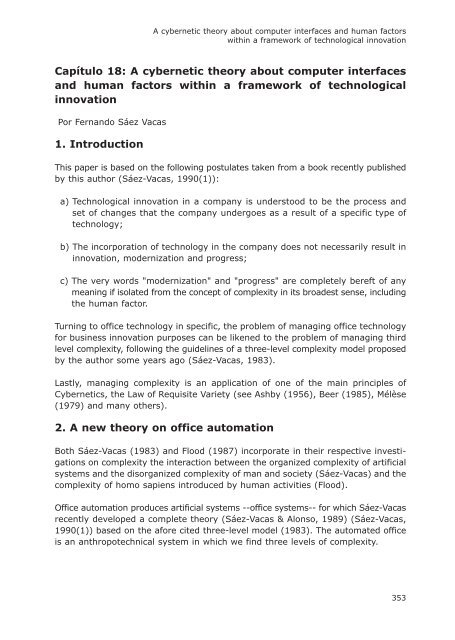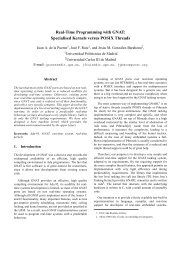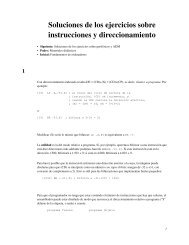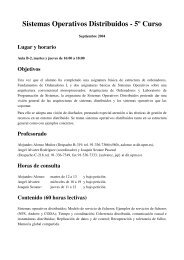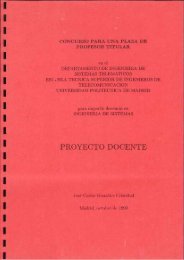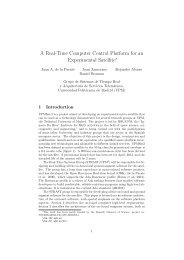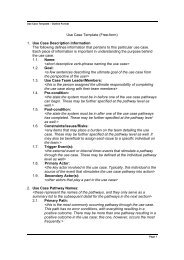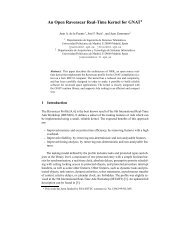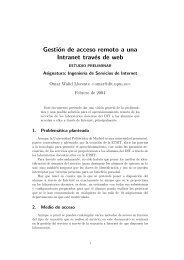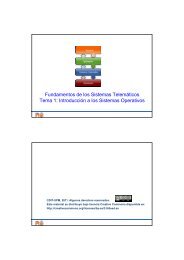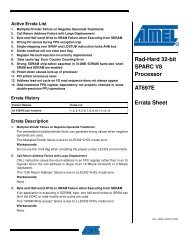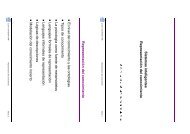- Page 2:
Complejidad y Tecnologíasde la Inf
- Page 5 and 6:
Interacciones significativas.......
- Page 7 and 8:
Bloque II: El modelo HxIxO=IOCAPÍT
- Page 9 and 10:
8. Medidas híbridas...............
- Page 12 and 13:
PrólogoPrólogoA primera vista, re
- Page 14 and 15:
PrólogoSi se mira desde el prisma
- Page 16 and 17:
Prólogoprecisamente en el año de
- Page 18 and 19:
PrólogoEn general, puedo decir que
- Page 20 and 21:
PrólogoEstoy convencido de que a l
- Page 22 and 23:
Orígenes e historia personal de la
- Page 24 and 25:
Orígenes e historia personal de la
- Page 26 and 27:
Orígenes e historia personal de la
- Page 28 and 29:
Orígenes e historia personal de la
- Page 30 and 31:
Orígenes e historia personal de la
- Page 32 and 33:
La variedad, en el sentido ciberné
- Page 34 and 35:
La variedad, en el sentido ciberné
- Page 36 and 37:
La variedad, en el sentido ciberné
- Page 38 and 39:
La variedad, en el sentido ciberné
- Page 40 and 41:
La variedad, en el sentido ciberné
- Page 42 and 43:
La variedad, en el sentido ciberné
- Page 44 and 45:
La variedad, en el sentido ciberné
- Page 46 and 47:
La variedad, en el sentido ciberné
- Page 48 and 49:
La variedad, en el sentido ciberné
- Page 50 and 51:
Conceptos relacionados con la compl
- Page 52 and 53:
Conceptos relacionados con la compl
- Page 54 and 55:
Conceptos relacionados con la compl
- Page 56 and 57:
Conceptos relacionados con la compl
- Page 58 and 59:
Conceptos relacionados con la compl
- Page 60 and 61:
Conceptos relacionados con la compl
- Page 62 and 63:
Conceptos relacionados con la compl
- Page 64 and 65:
Conceptos relacionados con la compl
- Page 66 and 67:
Conceptos relacionados con la compl
- Page 68 and 69:
Conceptos relacionados con la compl
- Page 70:
Conceptos relacionados con la compl
- Page 73 and 74:
Complejidad y Tecnologías de la In
- Page 75 and 76:
Complejidad y Tecnologías de la In
- Page 77 and 78:
Complejidad y Tecnologías de la In
- Page 79 and 80:
Complejidad y Tecnologías de la In
- Page 81 and 82:
Complejidad y Tecnologías de la In
- Page 83 and 84:
Complejidad y Tecnologías de la In
- Page 85 and 86:
Complejidad y Tecnologías de la In
- Page 87 and 88:
Complejidad y Tecnologías de la In
- Page 89 and 90:
Complejidad y Tecnologías de la In
- Page 91 and 92:
Complejidad y Tecnologías de la In
- Page 93 and 94:
Complejidad y Tecnologías de la In
- Page 95 and 96:
Complejidad y Tecnologías de la In
- Page 97 and 98:
Complejidad y Tecnologías de la In
- Page 99 and 100:
Complejidad y Tecnologías de la In
- Page 102 and 103:
Complejidad y sistemasCapítulo 4:
- Page 104 and 105:
Complejidad y sistemasSe dice que h
- Page 106 and 107:
Complejidad y sistemasLa clasificac
- Page 108 and 109:
Complejidad y sistemasFig. 1. Jerar
- Page 110 and 111:
Complejidad y sistemasAquí ya no e
- Page 112 and 113:
Complejidad y sistemasFig. 2. Siste
- Page 114 and 115:
Sistemas: visión estructural y vis
- Page 116 and 117:
Sistemas: visión estructural y vis
- Page 118 and 119:
Sistemas: visión estructural y vis
- Page 120 and 121:
Sistemas: visión estructural y vis
- Page 122 and 123:
Sistemas: visión estructural y vis
- Page 124 and 125:
Sistemas: visión estructural y vis
- Page 126 and 127:
Sistemas: visión estructural y vis
- Page 128 and 129:
Sistemas: visión estructural y vis
- Page 130 and 131:
Sistemas: visión estructural y vis
- Page 132 and 133:
Sistemas: visión estructural y vis
- Page 134 and 135:
Sistemas: visión estructural y vis
- Page 136 and 137:
Historia del enfoque sistémicoCap
- Page 138 and 139:
Historia del enfoque sistémicoÉst
- Page 140 and 141:
Historia del enfoque sistémicoT.G.
- Page 142 and 143:
Historia del enfoque sistémicoEn l
- Page 144 and 145:
Historia del enfoque sistémicoLa t
- Page 146 and 147:
Historia del enfoque sistémicode "
- Page 148 and 149:
Historia del enfoque sistémicoEn g
- Page 150 and 151:
Historia del enfoque sistémicoEs c
- Page 152:
Historia del enfoque sistémicoPers
- Page 155 and 156:
Complejidad y Tecnologías de la In
- Page 157 and 158:
Complejidad y Tecnologías de la In
- Page 159 and 160:
Complejidad y Tecnologías de la In
- Page 161 and 162:
Complejidad y Tecnologías de la In
- Page 163 and 164:
Complejidad y Tecnologías de la In
- Page 165 and 166:
Complejidad y Tecnologías de la In
- Page 167 and 168:
Complejidad y Tecnologías de la In
- Page 170 and 171:
Las jerarquíasCapítulo 8: Las jer
- Page 172 and 173:
Las jerarquíasCuando estudiamos lo
- Page 174 and 175:
Las jerarquíasAsí, en la Astrofí
- Page 176 and 177:
Las jerarquíasEn el caso de la cé
- Page 178 and 179:
Las jerarquíasOtro ejemplo en el q
- Page 180 and 181:
Las jerarquíasVeamos un ejemplo de
- Page 182 and 183:
Las jerarquíasDe esta definición
- Page 184 and 185:
Las jerarquíasInvitamos al lector
- Page 186 and 187:
Las jerarquíasrelojeros recibe a u
- Page 188 and 189:
Las jerarquíasNotas bibliográfica
- Page 190 and 191:
Textos sobre complejidadBloque II:
- Page 192 and 193:
Textos sobre complejidadReduccionis
- Page 194 and 195:
Textos sobre complejidadecuaciones
- Page 196 and 197:
Textos sobre complejidad2.2 Aspecto
- Page 198 and 199:
Textos sobre complejidad(...) compl
- Page 200 and 201:
Textos sobre complejidadcuanto a la
- Page 202 and 203:
Textos sobre complejidadEl precepto
- Page 204 and 205:
Textos sobre complejidadEn cualquie
- Page 206 and 207:
Textos sobre complejidad5. "Filosof
- Page 208 and 209:
Textos sobre complejidadEl computad
- Page 210 and 211:
Textos sobre complejidad7. Bibliogr
- Page 212 and 213:
Un marco universal para la construc
- Page 214 and 215:
Un marco universal para la construc
- Page 216 and 217:
Un marco universal para la construc
- Page 218 and 219:
Un marco universal para la construc
- Page 220 and 221:
Un marco universal para la construc
- Page 222 and 223:
Un marco universal para la construc
- Page 224 and 225:
Un marco universal para la construc
- Page 226 and 227:
Un marco universal para la construc
- Page 228 and 229:
Un marco universal para la construc
- Page 230 and 231:
Un marco universal para la construc
- Page 232 and 233:
Las tecnologías de la información
- Page 234 and 235:
Las tecnologías de la información
- Page 236 and 237:
Las tecnologías de la información
- Page 238 and 239:
Las tecnologías de la información
- Page 240 and 241:
Las tecnologías de la información
- Page 242:
Las tecnologías de la información
- Page 245 and 246:
Complejidad y Tecnologías de la In
- Page 247 and 248:
Complejidad y Tecnologías de la In
- Page 249 and 250:
Complejidad y Tecnologías de la In
- Page 251 and 252:
Complejidad y Tecnologías de la In
- Page 253 and 254:
Complejidad y Tecnologías de la In
- Page 255 and 256:
Complejidad y Tecnologías de la In
- Page 257 and 258:
Complejidad y Tecnologías de la In
- Page 259 and 260:
Complejidad y Tecnologías de la In
- Page 261 and 262:
Complejidad y Tecnologías de la In
- Page 263 and 264:
Complejidad y Tecnologías de la In
- Page 265 and 266:
Complejidad y Tecnologías de la In
- Page 267 and 268:
Complejidad y Tecnologías de la In
- Page 269 and 270:
Complejidad y Tecnologías de la In
- Page 271 and 272:
Complejidad y Tecnologías de la In
- Page 273 and 274:
Complejidad y Tecnologías de la In
- Page 275 and 276:
Complejidad y Tecnologías de la In
- Page 277 and 278:
Complejidad y Tecnologías de la In
- Page 279 and 280:
Complejidad y Tecnologías de la In
- Page 281 and 282:
Complejidad y Tecnologías de la In
- Page 284 and 285:
Complejidad y sistemas distribuidos
- Page 286 and 287:
Complejidad y sistemas distribuidos
- Page 288 and 289:
Complejidad y sistemas distribuidos
- Page 290 and 291:
Complejidad y sistemas distribuidos
- Page 292:
Complejidad y sistemas distribuidos
- Page 295 and 296:
Complejidad y Tecnologías de la In
- Page 297 and 298:
Complejidad y Tecnologías de la In
- Page 299 and 300:
Complejidad y Tecnologías de la In
- Page 301 and 302:
Complejidad y Tecnologías de la In
- Page 303 and 304:
Complejidad y Tecnologías de la In
- Page 305 and 306:
Complejidad y Tecnologías de la In
- Page 307 and 308:
Complejidad y Tecnologías de la In
- Page 309 and 310:
Complejidad y Tecnologías de la In
- Page 311 and 312:
Complejidad y Tecnologías de la In
- Page 313 and 314:
Complejidad y Tecnologías de la In
- Page 315 and 316:
Complejidad y Tecnologías de la In
- Page 317 and 318:
Complejidad y Tecnologías de la In
- Page 319 and 320:
Complejidad y Tecnologías de la In
- Page 321 and 322:
Complejidad y Tecnologías de la In
- Page 324 and 325:
El desarrollo del softwareCapítulo
- Page 326 and 327:
El desarrollo del softwareDesde el
- Page 328 and 329:
El desarrollo del softwareFig. 2 Ca
- Page 330 and 331: El desarrollo del softwareAlgunos t
- Page 332 and 333: El desarrollo del software3.6. Docu
- Page 334 and 335: El desarrollo del software5. Resume
- Page 336 and 337: Iniciativa de Defensa Estratégica
- Page 338 and 339: Iniciativa de Defensa Estratégica
- Page 340 and 341: Iniciativa de Defensa Estratégica
- Page 342 and 343: Iniciativa de Defensa Estratégica
- Page 344 and 345: Iniciativa de Defensa Estratégica
- Page 346 and 347: Iniciativa de Defensa Estratégica
- Page 348 and 349: Iniciativa de Defensa Estratégica
- Page 350 and 351: Iniciativa de Defensa Estratégica
- Page 352 and 353: Iniciativa de Defensa Estratégica
- Page 354 and 355: Iniciativa de Defensa Estratégica
- Page 356 and 357: Iniciativa de Defensa Estratégica
- Page 358 and 359: Iniciativa de Defensa Estratégica
- Page 360 and 361: An integrated framework for office
- Page 362 and 363: An integrated framework for office
- Page 364 and 365: An integrated framework for office
- Page 366 and 367: An integrated framework for office
- Page 368 and 369: An integrated framework for office
- Page 370 and 371: An integrated framework for office
- Page 372 and 373: An integrated framework for office
- Page 374 and 375: An integrated framework for office
- Page 376 and 377: An integrated framework for office
- Page 378 and 379: An integrated framework for office
- Page 380: An integrated framework for office
- Page 385 and 386: Complejidad y Tecnologías de la In
- Page 387 and 388: Complejidad y Tecnologías de la In
- Page 389 and 390: Complejidad y Tecnologías de la In
- Page 391 and 392: Complejidad y Tecnologías de la In
- Page 393 and 394: Complejidad y Tecnologías de la In
- Page 395 and 396: Complejidad y Tecnologías de la In


